 Backend Development
Backend Development
 Python Tutorial
Python Tutorial
 Summarize and organize Python regular expression knowledge points
Summarize and organize Python regular expression knowledge points
Summarize and organize Python regular expression knowledge points
This article brings you relevant knowledge about python, which mainly introduces issues related to regular expressions. A regular expression (Regular Expression) is a string that can represent Let’s take a look at a piece of regular information. I hope it will be helpful to everyone.

Recommended learning: python video tutorial
1.1 Regular expression
Regular expression An expression (Regular Expression) is a string, it can represent a regular piece of information. Python comes with a regular expression module, through which you can find, extract, and replace a regular piece of information. It is difficult to find one person among ten thousand people, but it is easy to find one very "characteristic" person among ten thousand people. Suppose there is a person with green skin and a height of three meters. Even if this person is among ten thousand people, others can find him at a glance. This "searching" process is called "matching" in regular expressions. In program development, if you want a computer program to find the required content from a large piece of text, you can use regular expressions. There are following steps to use regular expressions.
(1) Look for patterns.
(2) Use regular symbols to express rules.
(3) Extract information.
1.2 Basic symbols of regular expressions
1.2.1 Dot “.”
A dot can replace any a character except the newline character, including but not limited to English letters, numbers, Chinese characters, English punctuation marks and Chinese punctuation marks.
1.2.2 Asterisk “ * ”
An asterisk can represent the subexpression in front of it (ordinary characters, another or several regular expression symbols) 0 times to unlimited times.

All of the above are acceptable: (the asterisk represents the previous expression) 
1.2.3 Dot asterisk ".* ”
The dot represents any non-newline character, and the asterisk represents matching the character before it 0 times or any number of times. So ".*" means matching a string of any length any number of times. 
All of the above are acceptable:
It means that "any number of any characters other than newline characters" appear between "such" and "ha". 
1.2.4 Question mark “? ”
The question mark represents 0 or 1 times of the subexpression before it. Note that the question mark here is the English question mark 
. All of the above are acceptable: 
1.2.5 Dot and asterisk question mark “.*?” (most commonly used)
Usage after combination: 
All of the above can be used: 
Note: The difference between ".*?" and ".*"
. *? It means to match the shortest string that can meet the requirements.
One sentence summary is as follows.
① ".*": Greedy mode, obtain the longest string that meets the conditions.
② ".*? ": Non-greedy mode, obtain the shortest string that meets the conditions.
1.2.6 Parentheses "()"
"Extract" part of the content from a string.
There is the following string: 
As you can see, the password here has an English colon on the left and a Chinese character "you" on the right. When constructing a regular expression: .*? When you, the result will be: 
However, the colon and the Chinese character "you" are not part of the password. If you only want "12345abcde", you need to use brackets: 
get:
1.2.7 Backslash “ \ ”
In regular expressions, many symbols have special meanings, such as question marks, asterisks, braces, square brackets and parentheses. Backslash needs to be used in conjunction with other characters to turn special symbols into ordinary symbols, and ordinary symbols into special symbols. 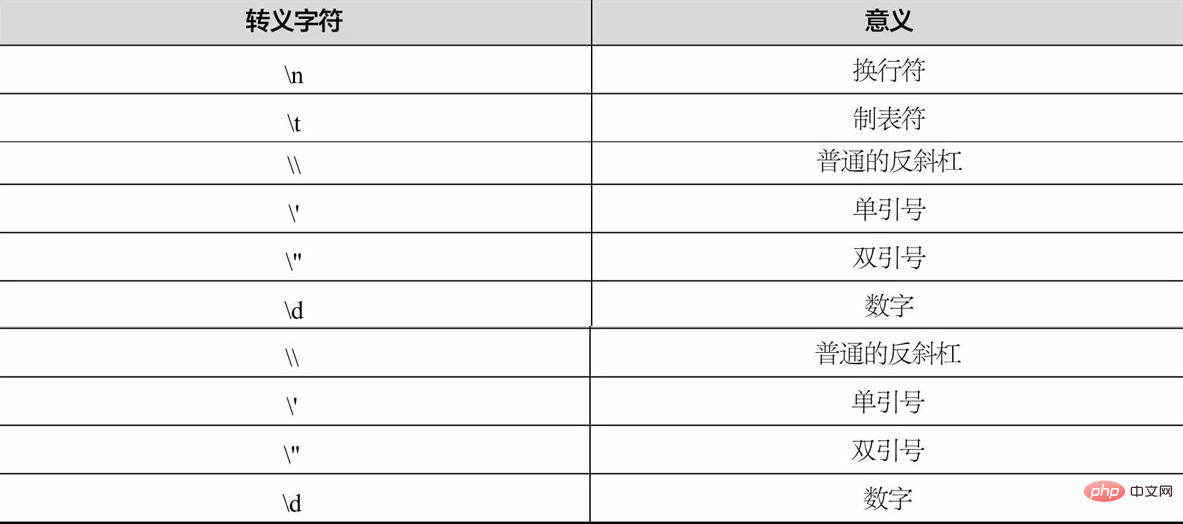
1.2.8 Number “\d”
Use “\d” in regular expressions to represent one digit.
If you want to extract two numbers, you can use \d\d; if you want to extract three numbers, you can use \d\d\d. But what if you don’t know how many digits this number has? You need to use the * sign to represent an arbitrary number.

All can be represented by the following regular expression: 
1.3 Using regular expressions
The name of Python's regular expression module is "re", which is the abbreviation of "regular expression". In Python, you need to import this module first before using it. The imported statement is:
import re
1.3.1 findall method
Python’s regular expression module contains a findall method, which can return all items that meet the requirements in the form of a list String.
The function prototype of findall is:
re.findall(pattern,string,flags=0)
pattern represents a regular expression, string represents the original string, and flags represents some special function flags. The result of findall is a list containing all matching results. If no results are matched, an empty list will be returned.
When you need to extract certain content, use parentheses to enclose the content so that you will not get irrelevant information. How to return if it contains multiple "(.*? )"? As shown in Figure 3-2, what is returned is still a list, but the elements in the list become tuples. The first element in the tuple is the account number, and the second element is the password. 
There is a flags parameter in the function prototype. This parameter can be omitted. When not omitted, it has some auxiliary functions, such as ignoring case, ignoring newlines, etc.
Here we take ignoring newlines as an example to illustrate. To ignore newlines, you need to use the "re.S" flag. 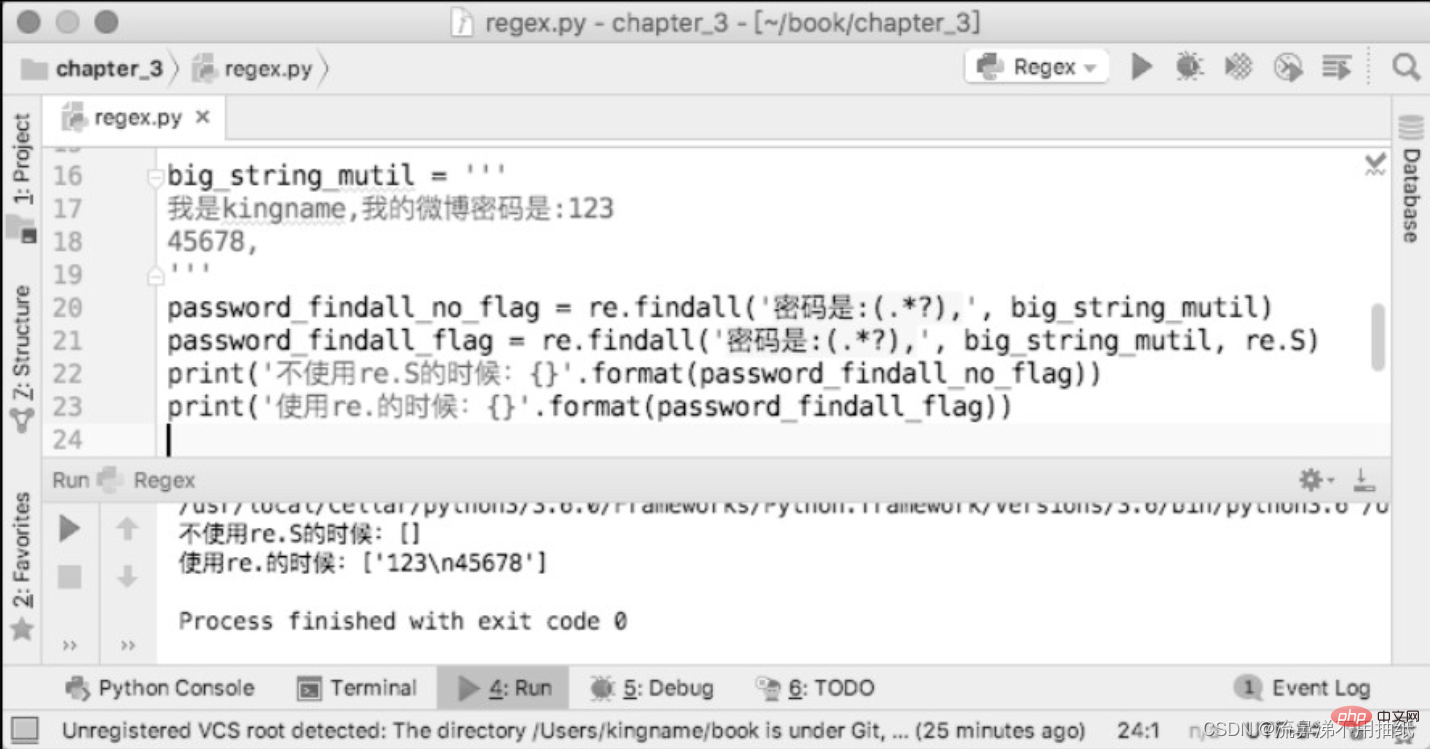
Although the symbol "\n" appears in the matched results, it is better than getting nothing. The line breaks in the content can be replaced when cleaning the data later.
1.3.2 search method
The usage of search() is the same as that of findall(), but search() will only return the first string that meets the requirements. Once it finds something that matches the requirements, it stops looking. It is especially useful for finding only the first data from a super large text, which can greatly improve the running efficiency of the program.
The function prototype of search() is: 
For the result, if the match is successful, it is a regular expression object; if no data is matched, it is None.
If you need to get the matching result, you need to use the .group() method to get the value inside. 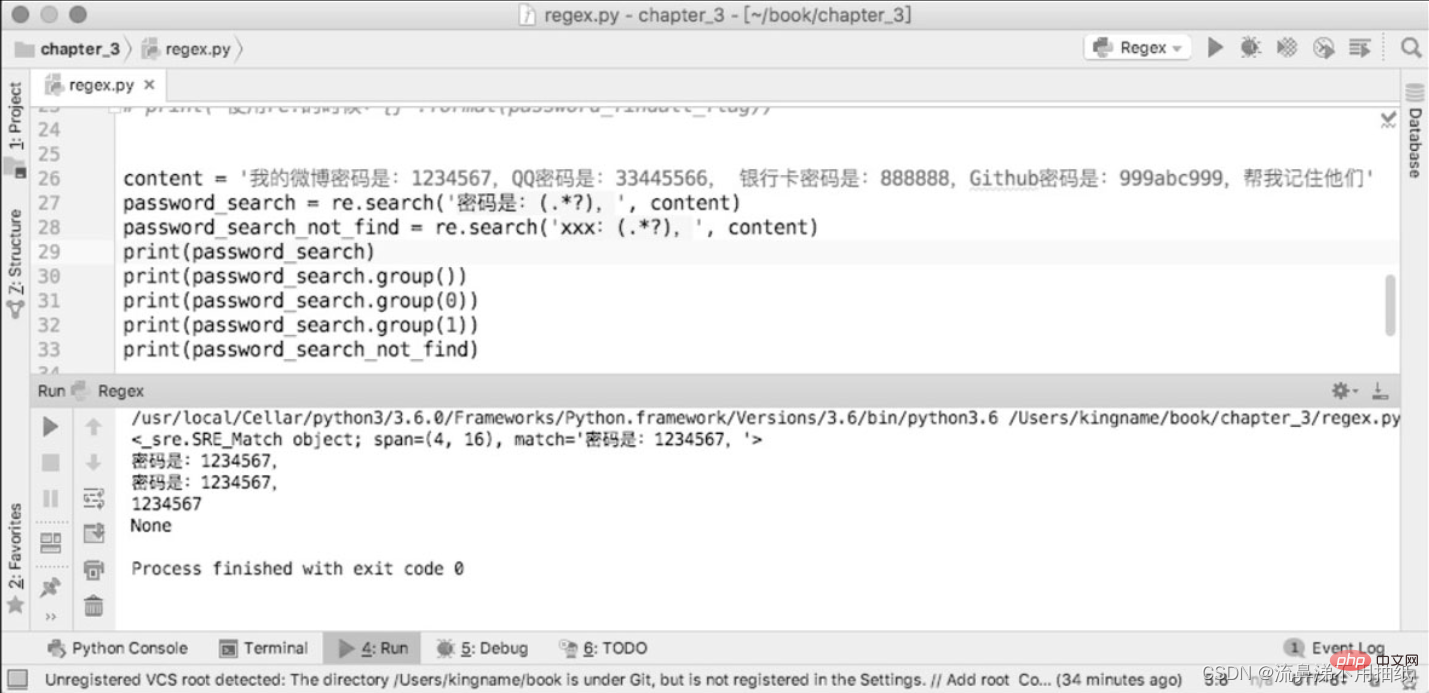
Only when the parameter in .group() is 1, will the result in the brackets in the regular expression be printed.
.group() parameters cannot exceed the number of parentheses in the regular expression. A parameter of 1 means reading the content in the first bracket, a parameter of 2 means reading the content in the second bracket, and so on.
(Note that the one in the picture is not findall) 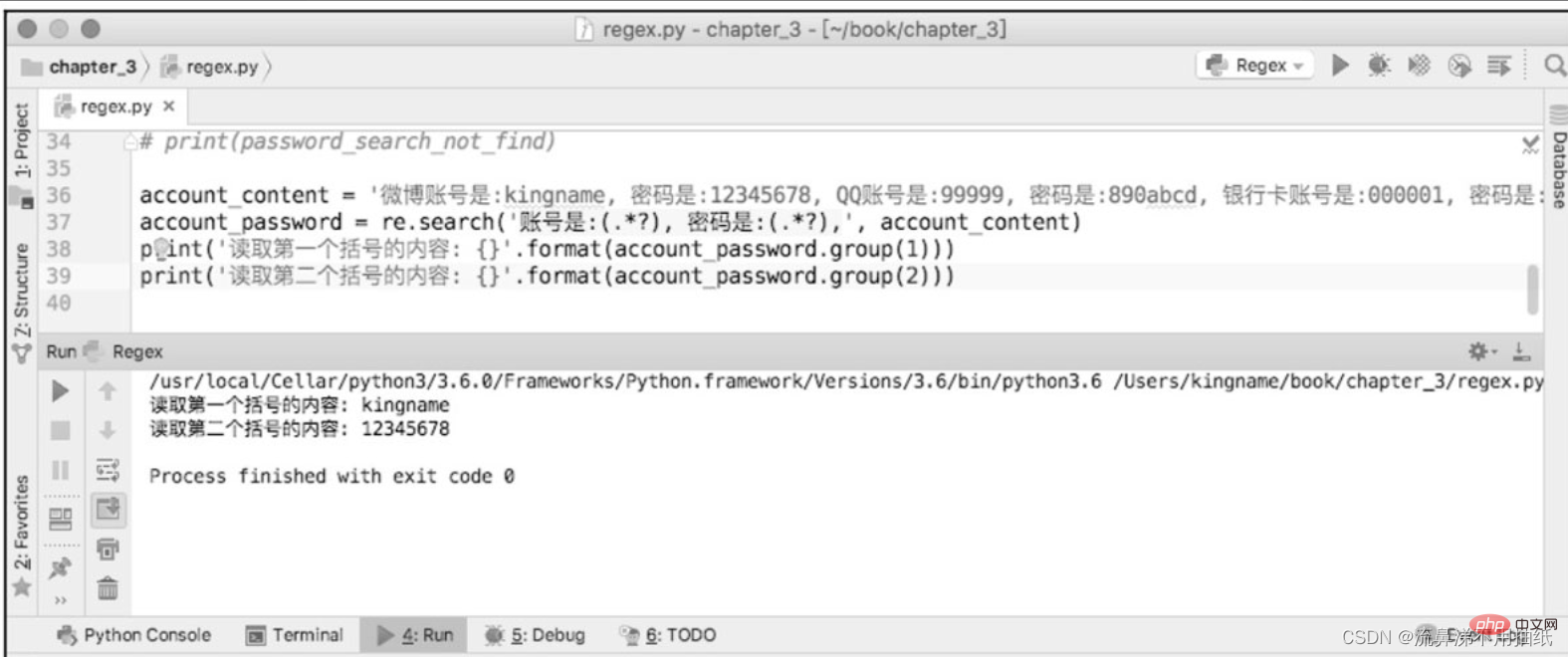
1.3.3 compile method
re.findall() comes with the function of re.compile(), so There is no need to use re.compile().
1.4 Regular expression extraction techniques
1.4.1 First grasp the big ones and then the small ones: secondary extraction
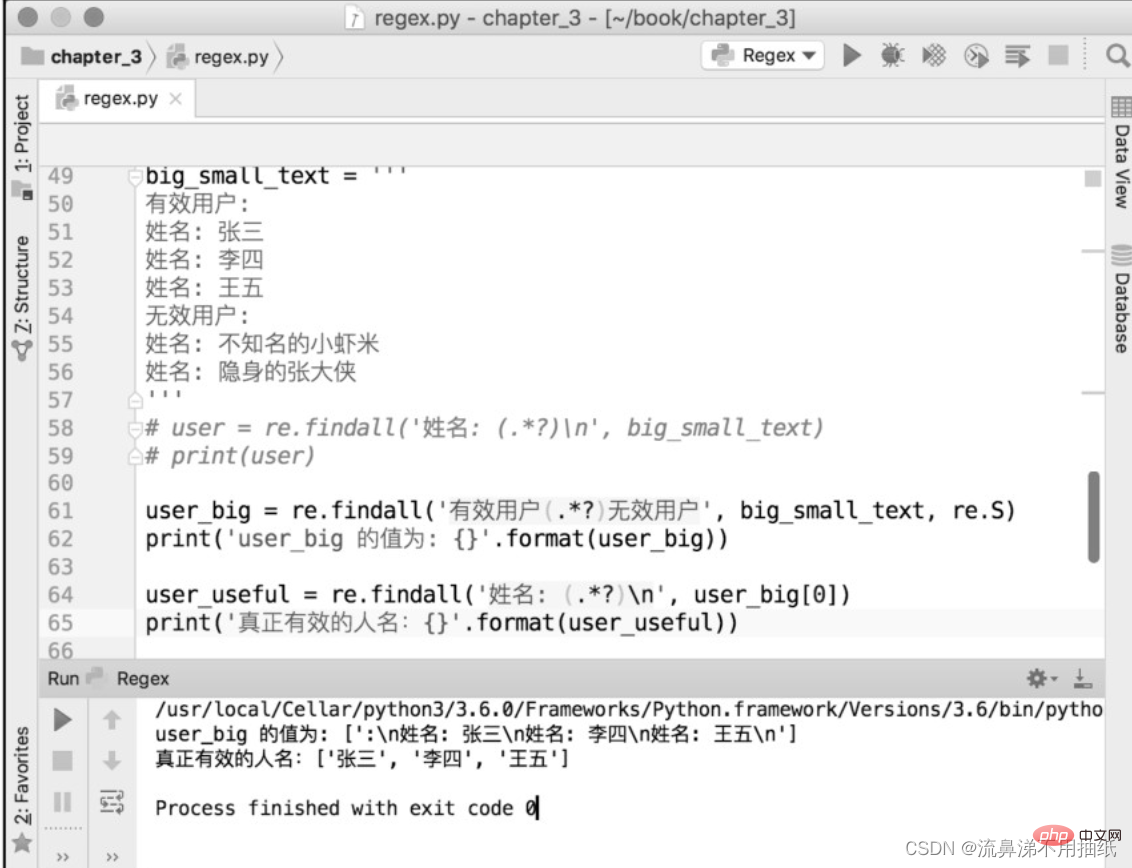
1.4.2 Inside the brackets Outside the brackets
There can be other characters inside the brackets.
See the figure below for specific impacts. 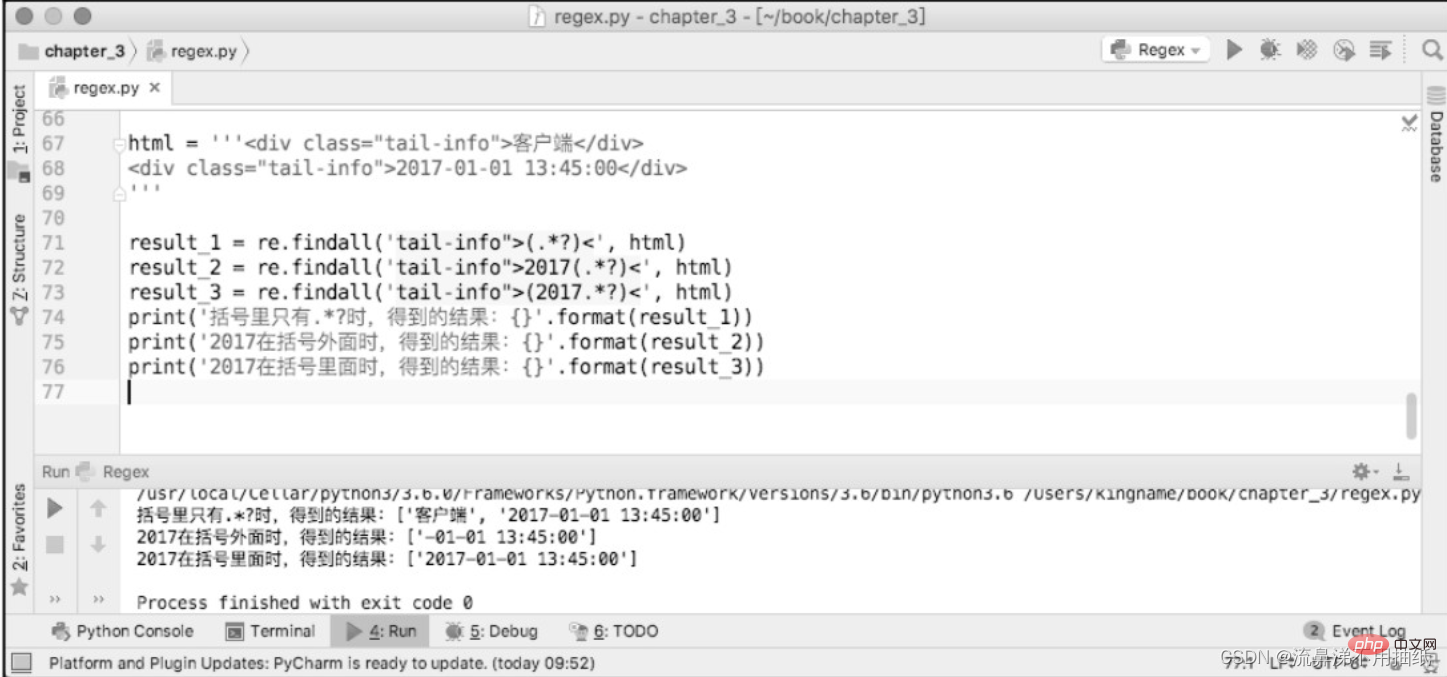
If there are other ordinary characters in the brackets, these ordinary characters will appear in the obtained results.
Recommended learning: python video tutorial
The above is the detailed content of Summarize and organize Python regular expression knowledge points. For more information, please follow other related articles on the PHP Chinese website!

Hot AI Tools

Undresser.AI Undress
AI-powered app for creating realistic nude photos

AI Clothes Remover
Online AI tool for removing clothes from photos.

Undress AI Tool
Undress images for free

Clothoff.io
AI clothes remover

Video Face Swap
Swap faces in any video effortlessly with our completely free AI face swap tool!

Hot Article

Hot Tools

Notepad++7.3.1
Easy-to-use and free code editor

SublimeText3 Chinese version
Chinese version, very easy to use

Zend Studio 13.0.1
Powerful PHP integrated development environment

Dreamweaver CS6
Visual web development tools

SublimeText3 Mac version
God-level code editing software (SublimeText3)

Hot Topics
 1669
1669
 14
14
 1428
1428
 52
52
 1329
1329
 25
25
 1273
1273
 29
29
 1256
1256
 24
24
 PHP and Python: Different Paradigms Explained
Apr 18, 2025 am 12:26 AM
PHP and Python: Different Paradigms Explained
Apr 18, 2025 am 12:26 AM
PHP is mainly procedural programming, but also supports object-oriented programming (OOP); Python supports a variety of paradigms, including OOP, functional and procedural programming. PHP is suitable for web development, and Python is suitable for a variety of applications such as data analysis and machine learning.
 Choosing Between PHP and Python: A Guide
Apr 18, 2025 am 12:24 AM
Choosing Between PHP and Python: A Guide
Apr 18, 2025 am 12:24 AM
PHP is suitable for web development and rapid prototyping, and Python is suitable for data science and machine learning. 1.PHP is used for dynamic web development, with simple syntax and suitable for rapid development. 2. Python has concise syntax, is suitable for multiple fields, and has a strong library ecosystem.
 How to run sublime code python
Apr 16, 2025 am 08:48 AM
How to run sublime code python
Apr 16, 2025 am 08:48 AM
To run Python code in Sublime Text, you need to install the Python plug-in first, then create a .py file and write the code, and finally press Ctrl B to run the code, and the output will be displayed in the console.
 PHP and Python: A Deep Dive into Their History
Apr 18, 2025 am 12:25 AM
PHP and Python: A Deep Dive into Their History
Apr 18, 2025 am 12:25 AM
PHP originated in 1994 and was developed by RasmusLerdorf. It was originally used to track website visitors and gradually evolved into a server-side scripting language and was widely used in web development. Python was developed by Guidovan Rossum in the late 1980s and was first released in 1991. It emphasizes code readability and simplicity, and is suitable for scientific computing, data analysis and other fields.
 Python vs. JavaScript: The Learning Curve and Ease of Use
Apr 16, 2025 am 12:12 AM
Python vs. JavaScript: The Learning Curve and Ease of Use
Apr 16, 2025 am 12:12 AM
Python is more suitable for beginners, with a smooth learning curve and concise syntax; JavaScript is suitable for front-end development, with a steep learning curve and flexible syntax. 1. Python syntax is intuitive and suitable for data science and back-end development. 2. JavaScript is flexible and widely used in front-end and server-side programming.
 Golang vs. Python: Performance and Scalability
Apr 19, 2025 am 12:18 AM
Golang vs. Python: Performance and Scalability
Apr 19, 2025 am 12:18 AM
Golang is better than Python in terms of performance and scalability. 1) Golang's compilation-type characteristics and efficient concurrency model make it perform well in high concurrency scenarios. 2) Python, as an interpreted language, executes slowly, but can optimize performance through tools such as Cython.
 Where to write code in vscode
Apr 15, 2025 pm 09:54 PM
Where to write code in vscode
Apr 15, 2025 pm 09:54 PM
Writing code in Visual Studio Code (VSCode) is simple and easy to use. Just install VSCode, create a project, select a language, create a file, write code, save and run it. The advantages of VSCode include cross-platform, free and open source, powerful features, rich extensions, and lightweight and fast.
 How to run python with notepad
Apr 16, 2025 pm 07:33 PM
How to run python with notepad
Apr 16, 2025 pm 07:33 PM
Running Python code in Notepad requires the Python executable and NppExec plug-in to be installed. After installing Python and adding PATH to it, configure the command "python" and the parameter "{CURRENT_DIRECTORY}{FILE_NAME}" in the NppExec plug-in to run Python code in Notepad through the shortcut key "F6".



